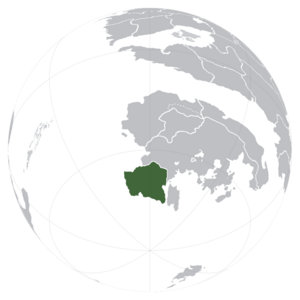Sequoyah
Republic of Sequoyah ᎠᏰᎵᎤᏙᏢ ᏍᏏᏉᏯ | |
|---|---|
Motto: ᎠᎵᎢᎵᏒ, ᎤᏁᏉᏤᎯ, ᎡᎷᏪᎢ (Progress, Prosperity, Peace) | |
Anthem: Sequoyan Battle Hymn | |
Location of Sequoyah in Sur | |
| Capital | Asequi |
| Largest city | Kalgaduv |
| Official languages | Sequoyan |
| Recognised regional languages | Caprican, Cheyall, Creeperian, Navaja |
| Ethnic groups (2021) | 10.05% Creeperans |
| Demonym(s) | Sequoyan |
| Government | Federal presidential republic |
| Atohi Dustu (GAU) | |
| Mantotohpa Otoahhastis (GAU) | |
| Legislature | Congress of Sequoyah |
| Senate | |
| People's Assembly | |
| Establishment | |
| 1516 | |
| 17 February 1876 | |
| 1912 | |
| 5 December 2020 – 5 December 2022 | |
| 21 May 2022 | |
| 5 December 2022 | |
| Area | |
• Total | 1,154,042 sq mi (2,988,960 km2) (10th) |
| Population | |
• 2022 estimate | 39,437,837 |
• Density | 34.28/sq mi (13.2/km2) |
| Gini (2022) | high |
| HDI (2022) | medium |
| Currency | Sequoyan dollar (SQY) |
| Time zone | AMT–5 and –6 |
Sequoyah (Sequoyan: ᏍᏏᏉᏯ, transliteration: Ssiquoya; Sequoyan pronunciation: [siːˈkɔɪ.jə]), officially the Republic of Sequoyah (ᎠᏰᎵᎤᏙᏢ ᏍᏏᏉᏯ, Ayeliudotlv Ssiquoya), is a country located in southern Sur. It is bordered to the north by Creeperopolis and surrounded on the east by the Asequi Strait and to the south and west by the Southern Ocean. With an area of 1,154,042 miles (1,857,251 km) divided into 6 provinces, Sequoyah is the third largest country in Sur and the tenth largest in the world. Sequoyah's largest and capital city is Asequi. As of 2022, Sequoyah has a population of 39.4 million.
Humans arrived in modern-day Sequoyah around 24,000 years ago. Around 3500 BC, migrants of the prehistoric-Creeperian diaspora arrived in Sequoyah and displaced the peoples already inhabiting the area. This displacement began the split between Sequoyans—who inhabited the coastal areas—and Tribals—who inhabited the inland regions. Several kingdoms arose throughout the following millennia, and warfare between Sequoyans and Tribals was common. In the early-1500s, the Empire of Sequoyah united all Sequoyans and Tribals under one state and forced out Creeperian colonists in northeastern Sequoyah by 1518. The empire fell in 1876 and splintered into four states: the Republic of Sequoyah, the Kingdom of the Cheyall, the Kingdom of the Navaja, and the Caprican Republic. Sequoyah reunited all four states in 1912 following a coup d'état in 1900 which established a military dictatorship. The dictatorship allowed reform in 1943 and led to the establishment of a personalist dictatorship under Prime Minister Diwali Ustya which held power until it was overthrown in 1959. The following year, a new political system was established and remained intact until the Sequoyan Civil War and the government's overthrow by the Cooperation and Development Coalition (CODECO) in 2020. A new constitution was adopted in 2021 the National Reconstruction Party has ruled the country since 2022 with CODECO's external support.
Contents
Etymology
The origin of the name Sequoyah (ᏍᏏᏉᏯ, Ssiquoya) is unknown, but linguists generally believe that the name derives from the Sequoyan word siqua (ᏏᏆ), meaning "hog", arguing that "Sequoyah" means "place of hogs" in the Sequoyan language.
History
Prehistory
The Sequoyan tribes followed migrating bison herds on horseback. Where they originally came from is unknown, as Sequoyan written history speaks only of the "Land northward" as where they originated from. Over 1000 years, the Sequoyan tribe began farming and forming towns while the Navaja and Cheyall chose to continue pursuing a nomadic lifestyle while the Sequoyans began farming and formed a centralized polical strucuture. As the Sequoyans settled on the cost of the Senvarian sea (which allowed their population to grow), the other tribes remained on the plains inland. Over time, the Sequoyans developed metalworking, writing, and pottery independently. Several smaller tribes developed (such as the Capricans, bringing the entire number of tribes in Sequoyah to 13.
Post-diaspora era
Empire of Sequoyah
From 1509-1532, under the reign of Sequoyah I, the Sequoyan tribe pushed the pastoralist Navaja and Cheyall tribes out of Eastern Sequoyah entirely. This expansion was brought to an abrupt end by religious turmoil within the Sequoyan tribe, as some religious leaders began to challenge the Creeperian Catholic Church's authority, claiming that it had warped the bible to gain political and economic power. Religious divisions within Sequoyah lead to the 5 years war within the tribe, as a group calling themselves the Samaritans (after the biblical group) overthrew Sequoyah I who was then exiled to Creeperopolis.
In 1533, Odysseus I took the throne as chieftan of the Sequoyah Tribe. Under his reign, a trading relationship with the Navaja and Cheyall tribes, trading farmed goods and metal tools in exchange for bison meat and animal furs. Odysseus also founded the Sequoyan Church, which supported a personal relationship with God and access to the bible for all. This was known as the Good time. This time of relative peace under Odysseus would last until his death in 1570. After his death, the Odyssian Dynasty consisting of his line would hold power in the chiefdom for nearly 300 years. The dynasty supported the power of the Sequoyan Church, expanding trade networks with other tribes, and pushing towards technological innovation.
Fall of the empire
Military dictatorship
Ustya Era
Modern Sequoyah
Politics
Politics in Sequoyah are dominated by two political parties: The Whigs and the Federalists. The Federalists support manufacturing, tarriffs, and large government intervention in the economy and are socially liberal, while the Whigs support a farming based economy, free trade, and lassiez-faire economics. They also favor social conservatism. Both parties support the Sequoyan Transcontinental Railroad and the assimilation of the native tribes. The ability to pass laws is held by the Congress, while the President is supreme commander of the military. Sequoyah is divided into two legislative districts: Kalgaduv in the west, and Eastern Sequoyah in the East. Each district sends 5 senators to the Senate, while the House membership is determined by population. Currently, the Federalists control the West, while the East is controlled by the whigs. Each province can make its own laws so long as those laws don't contradict federal ones. Itse Gadu is more autonamous than the other cities. Although it has no seat in Congress, Vegas can make its own laws whether they contradict federal law or not, so long as they pay taxes to the Federal government as set by Congress.
Geography
Topography
Climate
Flora and fauna
Government and politics
Political system
Foreign relations
Military
Administration divisions
Economy
Eastern Sequoyah grows cotton, tobacco, and corn. Western Sequoyah is known for their manufacturing industries, which produce firearms, steel, and luxury goods. There are substantial coal deposits in Western Sequoyah. Iron mines are the primary source of income in Itse Ulagohisdi.





